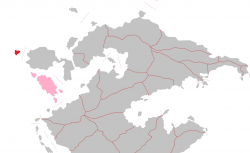Puerto Pollo (Pacifica)
Commonwealth of Puerto Pollo | |
|---|---|
|
Flag | |
Motto: Pappapishu! | |
Anthem: La Espadera | |
 Location of Puerto Pollo (red) in Pacifica. Bruuma shown in pink. | |
| Location | North-West Cordilla. |
| Capital and largest city | Danjer Cove |
| Official languages | Spanish |
| Religion (2022) | Christianity 58%
No religion 27% Folk religion 14% |
| Demonym(s) | Puerto Polloan |
| Government | Devolved one-party socialist dependency |
• Capitano Maximo | Daniel “El Pollo Diablo” Mendoza |
| Legislature | National Council |
| Formation | |
• Foundation of Danjer Cove | 1690 |
• Foundation of the Colony of Puerto Pollo | 1700 |
• Establishment of the Republic of Puerto Pollo | 1897 |
• Establishment of the Commonwealth of Puerto Pollo | 2014 |
| Area | |
• Total | 3,400 km2 (1,300 sq mi) |
| Population | |
• 2022 census | 830,694 |
• Density | 244.32/km2 (632.8/sq mi) |
| GDP (nominal) | estimate |
• Total | $7 billion |
• Per capita | $8,400 |
| Currency | Ipecacuanha |
Puerto Pollo, officially the Commonwealth of Puerto Pollo, is a dependency of Bruuma in North-West Cordilia.
Based on a tropical island, Puerto Pollo is a developing country with a lower-middle-income economy. Its source of income are varied and include agriculture (coffee, cocoa, banana), maritime, tourism, service outsourcing and wholesale trade.
Illegal activities, such as coca cultivation and refining and trade of forbidden products, were once the backbone of the economy and are still widespread despite recent efforts to curb them down.
Officially a devolved one-party socialist dependency, it is a dictatorship led by Capitano Maximo Daniel “El Pollo Diablo” Mendoza on behalf of Bruuma.
History
The Native Age (5000 B.C. – 1690C.E.)
Puerto Pollo was first settled around 5.000 B.C. by tribes of hunter-gatherers. For thousands of years their descendents lived in villages scattered in the luscious forests of the island, practicing hunting and subsistence agriculture and frequently warring with each other.
The Colonial Age (1690 – 1897)
In 1690 Austral-speaking pirates established a base in Danjer Cove. In 1700 a Spanish-speaking transcontinental power invaded the island, expelled the pirates and annex Puerto Pollo as a colony, mixing with the native. In 1897 the Motherland, severely weakened by a war lost on its continent, conceded independence.
The First Puerto Pollo Republic (1897 – 1979)
The new country became the typical banana republic: the elite of wealthy plantation owners and traders monopolized the control of the authoritarian state. After 1945, the communists polarized the poor masses’ anger. In 1979 the communists were likely to win the elections; the Army in response staged a coup and established a military junta.
The First Puerto Pollo Civil War (1979 -1990)
The communists formed the Fuercas Armadas Revolucionarias de Puerto Pollo (FARPP) and a civil war ensued. As the fight went on, both factions lost view of their ideals and their ideological motives and became involved in drug trafficking and other criminal activities. In 1990 a South Pacific-brokered Peace Deal was finally signed by the war-weary factions.
The Second Puerto Pollo Republic (1990-2012)
Trafficking became the primary economic sector of the country, ruled by armed cartels. Discontent grew, not only among the poorest but also among former mid and low rank fighters. Former FARPP colonel Daniel “El Pollo Diablo” Mendoza formed the Pollos Endemoniados Revolucionarios (PER) militia.
The Second Puerto Pollo Civil war and current era (2012 - today)
In 2012 the government collapsed and a new civil war broke out between PER and the Fuerca Democratica Portuaria (FDP), a union of anti-PER militias integrated with former Ejercito de Puerto Pollo (EPP) units. On 3 March 2014 the Bruuman People’s Defence Forces invaded Puerto Pollo in its support a of PER and crushed the FDP in just six days. The VPRB then established the Protectorate of Puerto Pollo, now a Commonwealth, with El Pollo Diablo as its Capitano Maximo.
